
|
<<Back |
Greek
Isles Cruise
September
15-22, 2008 |
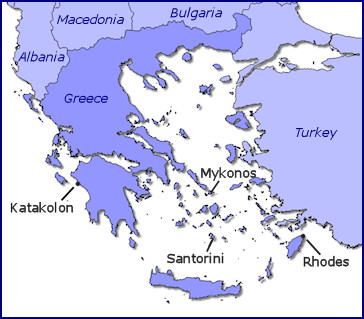
|
|
|
| It was to be a trip of celebration.
We were marking our 10th year of marriage while D’s
parents were commemorating an impressive 50 years of
matrimony. D’s mother had longed to see the Greek Isles,
and since she knew her opportunity would diminish with
each successive year, she arranged for a cruise that
would leave from Venice, take us through the Adriatic,
and make several of the more popular stops in Greece.
But as the pivotal day approached, health issues prevented
D’s parents from making the journey, and we were left
to go it alone. |
|
|
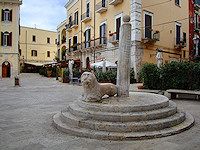
La Colonna Infame.
|
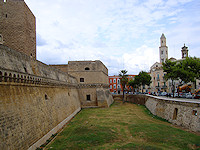
Along the Castello Normanno
Svevo.
|
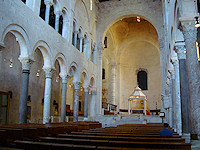
Inside the Cathedral of St.
Sabinus.
|
|
|
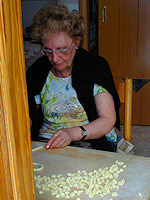
A Barese woman makes orecchiette.
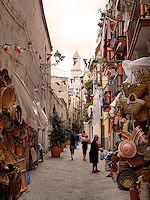
Shopping in the Barivecchia.
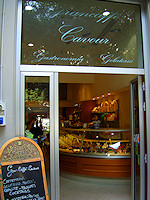
A J&D recommendation.
|
Our first port of call was
Bari on the heel of the Italian boot. This was our
opportunity to see how the disembarkation process
worked when dealing with European passengers. The
rules of etiquette tend to vary with nationality.
D’s German lineage puts him at a marked disadvantage
when it comes to ignoring rules, with so many freewheeling
Italians aboard, we somewhat expected the entrance
to the gangway to resemble a Roman traffic circle.
To our surprise and delight, however, only a handful
of people were waiting to leave the boat when we docked.
We suspected a variety of reasons were at play. First,
it was lunchtime when we reached Bari – a sacred time
to the European – and it was unlikely that many people
were willing to pass up their prepaid meals. Secondly,
all ship announcements were made in six languages
on a somewhat unintelligible PA system meaning that
many likely did not know where to go. But we surmised
that the prevailing reason was that people had little
interest in what Bari had to offer.
In the past, Bari’s reputation
was that of a rough-and-tumble industrial port rife
with unemployment and crime. While that has changed
in recent times, many feel the city still has little
to offer. As we researched the finer points of Bari
in preparation for the trip, we found it lambasted
by the cruising community. We had read postings like
“Bored in Bari” and “Nothing to see here”, and the
consensus was that this capital of the Puglia region
is most useful as a place to get somewhere else via
one of its many ferry services to Greece and beyond.
We decided to find some hidden beauty in this much
maligned town but got off to a rocky start as J announced
“It’s kinda ugly” when we disembarked. The old quarter
of Bari or Barivecchia is a collection of
quaint albeit tortuous alleys that rendered the complimentary
map issued to us by the cruise line utterly useless.
We took our chances and ambled around town to see
the better-known sights such as the 12th century castello,
the Colonna Infame where debtors were lashed in public,
and Bari’s jewel – the Basilica di San Nicola.
Saint Nicholas (although he
was never canonized) was born into a wealthy family
in what today is part of Turkey. He was known for
giving away his riches to the poor and eventually
became bishop of Myra. His most renowned deed involved
a poor farmer who had no hope of marrying off his
three daughters because they had no dowries. Each
year, Nicholas visited the man’s house late at night
to leave three purses of gold which eventually accrued
to a substantial dowry for each daughter. These purses
of gold are symbolized today by the three orbs used
to denote pawnshops (Nicholas is the patron saint
of pawn brokers). This tradition of gift giving became
synonymous with Saint Nicholas and of course forms
the basis of the Santa Claus legend. In the 11th century,
the bones of Saint Nicholas were stolen by some sailors
from Bari, and a new church was built in the saint’s
honor to house these relics.
Perhaps our most noteworthy
stop in Bari was Gran Caffè Cavour which had
an incredible selection of gelato, including a dozen
different chocolate flavors like cioccolato all'arancia,
bacio, cioccolato con pepperoncini,
and the silkiest Nutella gelato we have ever had.
|
|
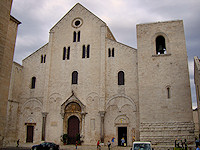
Basilica di San Nicola
|
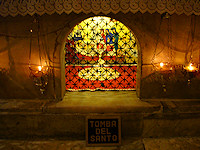
The reliquary of Saint Nicholas.
|

Saint Nicholas stands near the
entrance to the church.
|
|
|
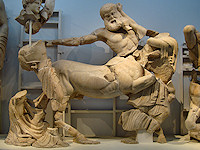
A centaur from the Temple of
Zeus.
|
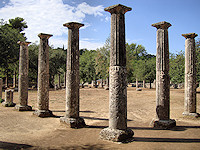
The palaestra at Olympia
|
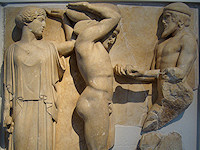
Hercules helps Atlas take a
load off.
|
|
|
In our travels, we have always
made it a point to visit the remnants of past Olympic
Games such as in Amsterdam, Lake
Placid, and Montreal and even more recent sites
like Turin
and Beijing, so it was a certainty that we would fork
out some extra coin to book one of the ship’s excursions
at Katakolon to visit Olympia. Located about 40 minutes
by bus inland at the foot of Mt. Kronos, the sanctuary
was known as Altis and included assorted temples but
none more famous than the Temple of Zeus. Not to be
confused with Mt. Olympus, the home of the Greek gods,
Olympia derives its name from Zeus Olympus, and it
was in the 5th century BC that Phidias sculpted a
40 ft statue of Zeus from ivory and gold regarded
as one of the Seven Wonders of the Ancient World.
Beginning in 776 BC, a sporting
event was held at the sanctuary in Zeus’ honor which
consisted of a single footrace of about 200 yards
called a stadion. Athletes from all over
Greece and its colonies would compete in the event
and even in times of war, a truce or ekecheiria
would take effect for the competition. Over the years,
more events such as additional footraces, boxing,
the ancient pentathlon, and chariot racing were added.
The games were held so consistently that the four
year period between stagings became known as an olympiad
and was used as a standard measure of time throughout
the Greek world.
The ancient Olympic games were
believed to be last held in 393 AD (some 290 stagings)
after which they were halted as Christianity took
hold in Greece. The sanctuary was largely destroyed
by an earthquake years later and then lost to memory
before being rediscovered in the 18th century. While
only ruins remain of Olympia today, the accompanying
museum has a small collection of recovered statues
and even parts of the reliefs depicting Herculean
labors that adorned the Temple of Zeus. Much of what
survives is attributed to the Romans who revived the
glory of the games and repaired many of the structures.
They added an aqueduct to supply the site with potable
water and opened the games to all citizens of the
empire. Excavations are still ongoing, and only last
year saw the discovery of the hippodrome several kilometers
away.
|
|
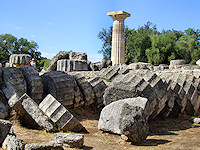
Little remains of Zeus' temple.
|
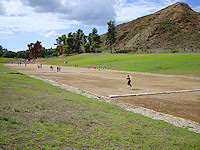
J runs a stadion.
|
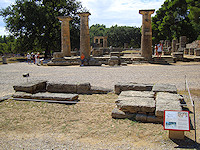
Where the flame is lit.
|
|
|
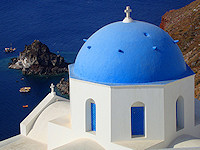
A blue-domed Greek Orthodox
church.
|
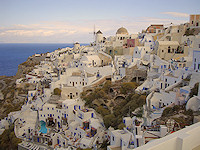
The sugarcube buildings of Oia.
|
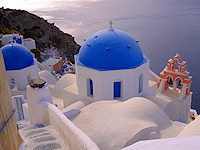
A view of Oia to the sea.
|
|
|
Not surprisingly, as we drifted
further south, the weather began to improve. We were
heading to the Cyclades, and we knew that clear blue
skies were a vital component in the picturesque Greek
island scenes that we had envisioned. Our first stumbling
block occurred the night before when we were informed
that the stay in Santorini would be shortened and
that unless you had booked a shore excursion through
the ship, you would have to wait an additional hour
and a half before disembarking. So essentially, we
were strong-armed into buying an excursion or we had
only 3 hours on the island. Compounding matters was
the fact that we had to tender ashore at a port below
the main town of Fira where you could either climb
500 steps, take a donkey up, or wait in line for a
cable car. Our intention was to spend as much time
as possible in Oia, a much quainter and appealing
village to the north, and then visit Fira if time
permitted. Some rough calculations clearly indicated
that we would have to book the cruise line’s excursion
to Oia if we wanted to see it at all. So we reluctantly
coughed up the $150 to get on the first tender of
the morning. As we waited for our bus number to be
called the next morning, the room began to empty until
only eight of us English-speakers remained. Upon inquiring
with the cruise staff, we were told that our number
had been called 30 minutes earlier. We learned later
that our number had actually been called in the waiting
room for the French-speaking passengers. So when we
finally got to the bus on shore, we took our seats
in the back after walking the gauntlet of disgruntled
French tourists who had been waiting for 45 minutes.
We apologized and announced we were Canadian to avoid
any further damage to US international relations.
Canada would just have to take this one on the chin.
It’s the least they could do.
Oia was as advertized. There
were some clusters of clouds overhead, but when the
sun poked through, the views were stunning. We have
not been many places that look exactly like the postcards,
but the scenes of blue-domed churches, windmills,
and white-washed sugar cube houses spilling down the
cliffs to the azure sea were breathtaking. Unfortunately,
the excursion permitted only an hour to take it all
in, so a leisurely stroll through the quaint little
streets was out of the question. Instead, we muscled
our way through the throngs of tourists to find the
small alleys that offered the most spectacular views.
Even so, we only just made it back to the bus for
Fira.
The locals call the crescent
shaped island Thira (Santorini is the derivative of
the Venetian name for it in honor of Saint Irene),
and along with Theresia and four uninhabited islands,
it makes up what remains of a large underwater volcano.
Although still active, the eruption that occurred
around 1640 BC formed the islands and destroyed the
Minoan civilization that inhabited the area. The resulting
caldera provides steep cliffs and deep-water ports
which benefit the large cruise ships. Fira sprawls
atop one of these cliffs and offers fantastic views
of the other islands. The town consists of a main
pedestrian thoroughfare lined with souvenir shops
and cafés that offer excellent vistas. As we
arrived in Fira by bus, we could already see the line
for the cable car stretching for blocks. With an hour
left to catch the last tender to the ship, we were
left with two options to get down to the port – by
foot or by donkey. The perils of traveling by donkey
down 588 steps covering a vertical drop of 900 ft
are obvious. The perils of walking in sandals where
donkeys travel regularly are equally obvious. J’s
old rugby knee injury caused her to consider the donkey
option briefly, but in the end, we decided to walk
it. We had descended several levels when traffic –
both human and equine – came to a standstill. A woman
ahead decided she had had enough and wanted to be
rid of her donkey, but she was unsure of how to dismount.
Meanwhile, the queue of people and animals was backing
up prompting one Englishman to politely call out “Madam,
would you kindly move your ass?”. The locals who drive
the donkey trains do not take kindly to tourists who
opt to walk the stairs rather than pay for donkey
transport and therefore don’t yield any right of way.
Thus, one of the donkey herders drove his train right
into the waiting tourists resulting in people being
pinned against the retaining walls. During the melee,
D had his foot trampled by the hoof of a surprisingly
heavy ass, sustaining his first ever donkey-related
injury. Angry, fatigued, and now hobbled, we bounded
down the rest of the steps, avoiding donkey droppings
along the way, only to find yet another line for the
tenders. We finally made it back to the ship to lick
our wounds – but not literally.
|
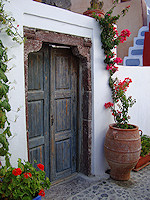
A Oian entrance.
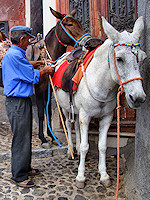
All aboard the donkey train.
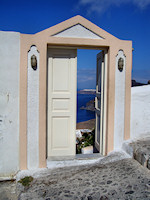
Watch your step.
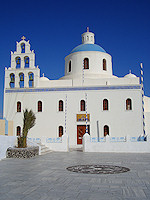
The Panagia Platsani in Oia.
|
|
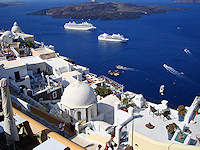
Nea Kameni - the still-active
volcanic cone.
|
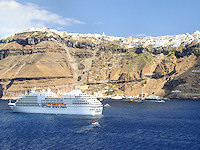
Fira from the sea.
|
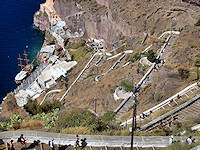
The steps leading down to Skála
Firón.
|
|
|
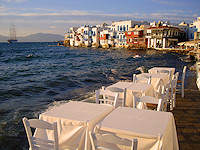
Table for two in Little Venice.
|
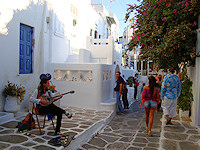
A leering lutist.
|
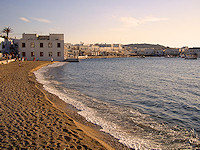
Mykonos beach.
|
|
|
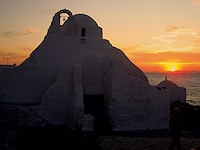
Sunset at Panagia Paraportiani.
|
Our respite was short-lived,
however, as we were due to go ashore again that evening
at Mykonos, an island with a thriving nightlife -
especially a gay one. Timing again played a role because
this picturesque island is also known for its spectacular
sunsets. Once again rushing ashore via the tendering
process to be in position for sunset, we made our
way through the crowded, twisting streets to see Little
Venice and the famous Mykonos windmills with only
minutes to spare. After the sun faded below the horizon,
we finally had some time to take a relaxing stroll
around town and sit at a harborside taverna
to enjoy a Greek coffee, a piece of kataifi,
and an ouzo chaser.
|
|
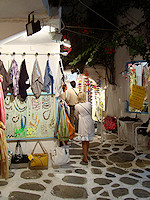
Nighttime shopping.
|
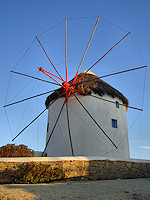
The famed windmills.
|
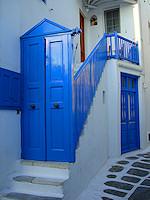
Painted doors.
|
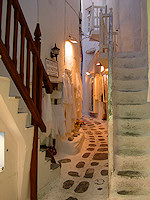
The streets of Chora.
|
|
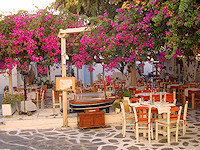
An appealing taverna.
|
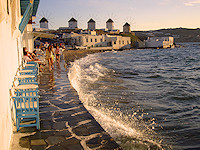
Islanders gather to watch the
sunset.
|
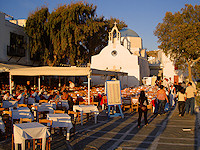
Dinner time.
|
|
|
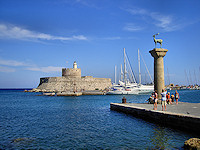
The presumed site of the Colossus.
|
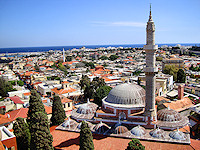
Suleiman's mosque in Rhodes.
|
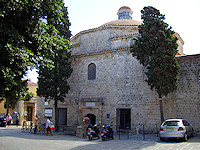
The Turkish baths.
|
|
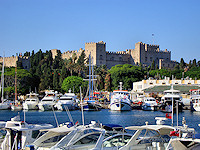
Palace of the Grand Masters.
|
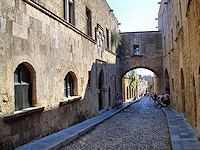
The Street of Knights.
|
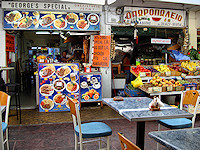
A gyro stop.
|
|
|
Our southernmost port of call
was the island of Rhodes just off of the Turkish coast.
According to legend, the island was the result of
relations between a nymph named Rhode and the sun
god Helios, thus beginning a long relationship with
Helios culminating in the construction of the Colossus.
This second Wonder of the World encountered during
our trip is also no longer there, but the bronze statue
once stood some 100ft tall and supposedly straddled
the entrance to the ancient harbor at Rhodes Town.
Experts are skeptical over the technical feasibility
of the figure straddling the harbor mouth, and speculate
that the statue appeared on one side of the entrance
looking more like the Statue of Liberty. In any event,
the towering statue spent more time on its side as
it was a victim of an earthquake in 226 BC which toppled
the Colossus 54 years after its construction. The
ruins remained a tourist attraction for 800 more years
before it was sold for scrap.
The proximity of Rhodes to
Turkey has always made the island a strategic and
coveted spot. In the early 14th century, the island
was purchased from the Genoese by the soon-to-be Knights
of Rhodes. These knights fortified the main town and
occupied the Collachium section of the town containing
the Street of Knights (Odos Ippoton) which hosted
the Inns of the Tongues – the meeting halls for knights
of various nationalities. The knights’ investments
paid off as Rhodes played a significant role in subsequent
crusading activities against the Turks. The end came
when Suleiman the Magnificent sacked Rhodes in 1523
but allowed the surviving knights to flee and set
up shop in Malta. Rhodes remained in Turkish hands
until 1912.
One direct result of this Turkish
occupation was the goal of our self-directed shore
excursion for the morning. In the center of Rhodes
town is a hamam which has been operating
for 250 years. Neither of us had ever experienced
a Turkish bath, so we dared one another to go through
with it. At the very least we would get to see the
inside of this historic bathhouse. We each bought
the full package for €15 and were issued a bowl, a
towel, and a locker before being led to separate sides
of the building. According to custom, the baths are
segregated by gender but the experiences are somewhat
similar. First we stripped down and were led to a
large marble-floored area having a number of basins
at which we bathed. Neither of us brought soap, so
this part of the experience amounted to sitting on
a stool and pouring warm water over ourselves for
about 20 minutes. Our accounts diverge slightly from
here as J was taken by a tanned, toned, and topless
Greek beauty into a private room for a massage. The
masseuse spoke no English but gestured for J to face
the wall on four points, not unlike a police pat-down.
The masseuse scrubbed down J with a soap mitt and
rinsed her with warm water after which J was led to
a marble table for kneading. Meanwhile, in another
section of the building, D was motioned by a slender,
Speedo-clad man to follow him to another private room
where D was invited to lay on the marble floor in
all his glory. He complied – first sunny-side up,
then over easy – each time being sudsed up and massaged.
Then, in a moment that instilled D with both surprise
and horror, the masseuse removed his Speedo, stood
over D with legs astride much like the fabled Colossus
himself, and asked “Are you ready for the final treatment?”
D could only muster a nervous reply of “I’m not sure.”
“Some people like it,” countered the masseuse and
added “Let’s give it a try”. D was as confused as
ever at this point and skittishly asked “What do I
have to do?” The masseuse gestured for him to follow
and led D back to the original bathing area where
they lay down side-by-side on the marble floor heated
by a fire in the bowels of the ancient building. D
and his newfound friend laid there for a spell sweating
and making small talk before the masseuse retired
to see to a new client. Seizing the opportunity, D
returned to his rinsing station, got dressed, and
waited for J at the café across the street.
We shared our experiences over a few beers and mutually
agreed that it was actually a very relaxing time.
We would do it again if the opportunity arose and
hoped that others would too as the owner told us that
closing the place down would be imminent unless more
tourists came.
|
|
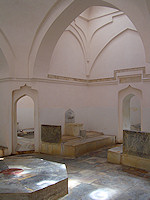
The gentlemen's bathing area.
|
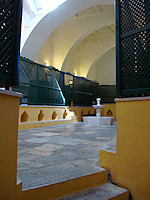
Inside the hamam.
|
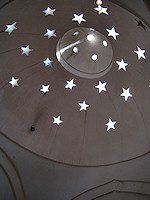
The hamam's starry dome.
|
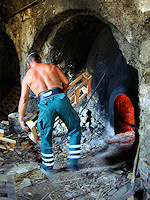
Maintaining the hot water.
|
|
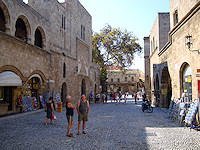
A typical Rhodian street scene.
|
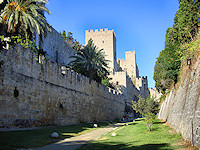
The Palace as seen from the
moat.
|
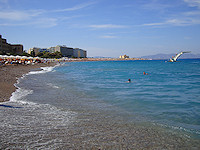
The dark sands of Elli Beach
in Rhodes.
|
|
|
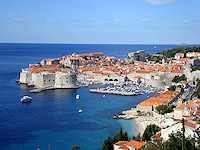
Dubrovnik - the Pearl of the
Adriatic.
|
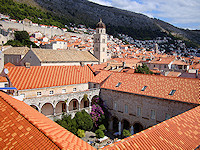
Courtyard of the Convent of
St. Claire.
|
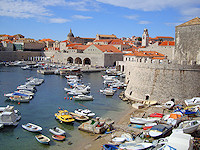
The old port.
|
|
|
After a day at sea, we eventually
arrived at our final stop, Dubrovnik. The dramatic
contrasting colors of the gray city walls, red clay
tile rooftops, and the azure water gives credence
to the Croatian city’s nickname – the Pearl of the
Adriatic. Founded on an isthmus in the 7th century,
its original name was Ragusa, and its mighty city
walls provided inhabitants with centuries of protection
from a variety of invaders. In time, the city came
under Venetian rule and prospered by trading with
other Mediterranean states. For 150 years, Ragusa
grew in wealth and power from its maritime commerce
and eventually gained independence from Venice in
the 14th century. After an earthquake in 1667 devastated
the city’s buildings and killed more than 5,000 inhabitants,
the city was rebuilt in its present Baroque style.
The arrival of Napoleon finally put an end to the
Republic of Ragusa, and the city was ceded to the
Hapsburg Empire by the French several years later.
After World War I, its name was officially changed
to Dubrovnik as it became part of Yugoslavia and then
finally an independent Croatia in the 1991. This final
transition came at great cost, however, when Serbs
destroyed the city with artillery during a seven-month
siege. International aid from a number of organizations
helped rebuild the city over a decade.
We anchored just outside the
ancient harbor and once again went through the tendering
process to go ashore, but by now, we knew how to work
the system to maximize our time on land. Despite our
best efforts, we were still left with only two hours
to see as much of Dubrovnik as we could. We began
ironically with a short walk leading away from the
port to position ourselves for a panoramic view of
the medieval walled city. Although this maneuver proved
costly in terms of time, it was certainly worth the
effort. Once back within the confines of the walls,
we did our best to relax and stroll around the limestone
streets polished by the footsteps of centuries. As
with comparable walled cities, Dubrovnik is filled
with narrow alleys that lead into large squares, and
the absence of motorized traffic makes for a pleasant
opportunity to browse the shops and vendors peddling
Croatian dolls and watercolors to buy those last-minute
souvenirs. Unfortunately, we didn’t have the luxury
of time, so we bypassed the window-shopping and even
lunch for a quick beer and a tour of the city walls.
The walls surrounding the city are in impeccable shape
(thanks to renovation efforts following the Balkan
conflict) and every guide book lists them as a can’t-miss
as they offer gorgeous views of the old town and the
surrounding Adriatic. With only two sets of stairs
as access points, the walls are open for walking and
can be circumnavigated in about 90 minutes. We had
only half of that time, so we had to make a hard decision
to cut out the lower, longer portion in favor of the
route that climbs slightly up Mt. Srd and offers more
picturesque vantage points. The crowds only inched
their way along the walls, so we had to squeeze past
as best we could while still keeping our footing.
The views certainly lived up to the hype, and we couldn’t
stop ourselves from lingering at several points to
take it all in. Eventually, we realized that this
bit of the wall was all we were going to be able to
experience during our brief visit, so we might as
well enjoy it. Having made it to the other end of
the city, we descended by Onofrio’s sixteen-sided
fountain and crept back down the main thoroughfare
to the main harbor.
We had heard that Dubrovnik’s
real essence comes out at night as people roam the
lamp-lit white streets searching for the right spot
to dine al fresco or enjoy a drink with friends,
but alas, we would have to experience that side of
Dubrovnik another time. The last few tenders were
already making their way back to the ship where we
would return to Venice and be on a plane back to the
US by morning - another successful trip in the books.
|
|
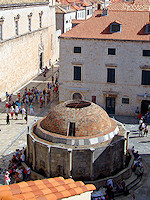
Onofrio's big fountain.
|
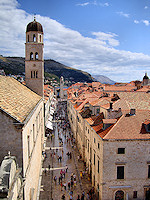
Looking down the Stradun.
|
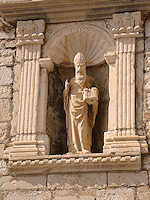
Saint Blaise
|
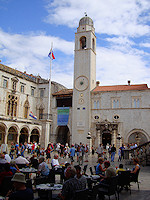
A bell tower near the port.
|
|
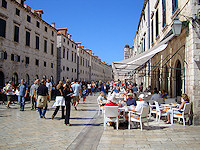
A nice spot for people watching.
|
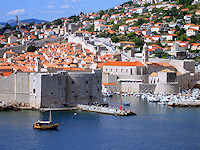
Fort St. John protects the old
port.
|
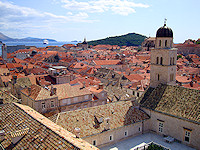
Our ship awaits our return.
|
|
Copyright © 2005 JnDsTravelog.com. All rights reserved. |
| |